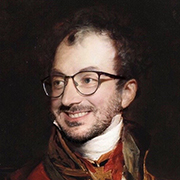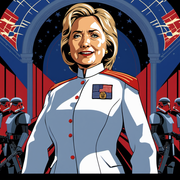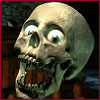|
Krankenstyle posted:The Jacob Riis Houses public housing project in New York City is named for him. I used to live near a community center named after Jacob A. Riis when I was a little kid, and my great-grandparents & their friends/relatives would play card games in front of it. I always used to wonder who Jacob A. Riis was, and I guess now I know. 
|
|
|
|

|
| # ? May 10, 2024 06:38 |
|
 https://twitter.com/sovietvisuals/status/1041992243731746816?s=21
|
|
|
Fidel Castro skiing in Russia:
|
|
|
|
|
Jesus christ it's like those meme pictures with Spider-Man with a tiny head.
|
|
|
|
Grem posted:Most likely locals. AIM rounded up locals and "guarded" them, essentially taking the town hostage. Walter Littlemoon has a really good accounting of what happened with AIM and by his account they all sound like a bunch of shitheads. Those faces look way too white for those to be locals honestly
|
|
|
|
 "Photograph of Anandibai Joshee (left) from India, Kei Okami (center) from Japan, and Tabat M. Islambooly (right) from Ottoman Syria, students from the Woman's Medical College of Pennsylvania. All three were the first woman from their respective countries to obtain a degree in Western medicine." (10 October 1885)
|
|
|
|
It's possible some Russians are bear-human hybrids. Olympic champion weightlifter Vasily Alexeev, who set 80 World records in competition, which was a Guiness record at the time for the most World records set.  Enjoying some liquid carbs. 
|
|
|
|
Say Nothing posted:Olympic champion weightlifter Vasily Alexeev, who set 80 World records in competition, which was a Guiness record at the time for the most World records set. I think I remember this guy from the '72 olympics.
|
|
|
|
  Walsh Brothers, First undisputed powered flight in NZ, 1911. The Brothers ran a flight school until the 1920s, supplying about 100 pilots to the RFC in WWI. In NZ they are completely obscure because of a Timaru farmer named Richard Pearse who possibly flew prior to the Wright Brothers in 1903, although by his own admission never managed more than uncontrolled hops. Jaguars! has a new favorite as of 08:03 on Sep 25, 2018 |
|
|
|
German war propaganda, 1914. The top line reads "Are we the barbarians?" and then come a number of comparisons with England and France. From top to bottom: Annual social insurance payments - number of illiterates per 10,000 recruits - expenses for education - number of published books - nobel prizes - patents (I didn't fact-check it, but I think it's certainly an interesting variety of wartime propaganda I hadn't seen before)
|
|
|
|
The Sausages posted:
Hey, she's an anime.
|
|
|
|
System Metternich posted:German war propaganda, 1914. The top line reads "Are we the barbarians?" and then come a number of comparisons with England and France. From top to bottom: Annual social insurance payments - number of illiterates per 10,000 recruits - expenses for education - number of published books - nobel prizes - patents The germans were very particular about appearing civilized since two of the major accusations against them were the shooting of Belgian civilians and unrestricted u-boat warfare, which were both seen as very uncivilized. Willy was big on the perception being A Knightly Gentleman and having the Germans be honorable in all that they do.
|
|
|
|
Man, the Germans sure do like putting numbers on things.
|
|
|
|
Solice Kirsk posted:Man, the Germans sure do like putting numbers on things. I could probably name six pre-1914 Nobel French or British Nobel laureates so that has to be bullshit.
|
|
|
|
duckmaster posted:I could probably name six pre-1914 Nobel French or British Nobel laureates so that has to be bullshit. I looked it up, there were six British Nobel laureates before 1914. It is possible to arrive at the German propaganda numbers though when you get a bit creative:
Just decide that those three don't meet your criteria for English laureates and you're set! I imagine that it's similar for the French numbers, though I guess it is even harder to arrive at three there - France had 16 laureates before WW1, after all. Interestingly enough they're also selling themselves a bit short - I'm counting 17 German laureates before 1914, but they only mention 14.
|
|
|
|
Maybe they didn't count these fellas? * Wilhelm Ostwald, born in then Russia, now Latvia, Chemistry, 1909 * Philipp Lenard, born in then Austria-Hungary, now Slovakia, Physics, 1905 * Theodor Mommsen, born in then Denmark, Literature, 1902 There's also a few with Jewish parentage (Wallach, Heyse, Ehrlich, Baeyer on a quick skim) but that probably wouldn't disqualify in 1914.
|
|
|
|
Solice Kirsk posted:Man, the Germans sure do like putting numbers on things.
|
|
|
|
System Metternich posted:German war propaganda, 1914. The top line reads "Are we the barbarians?" and then come a number of comparisons with England and France. From top to bottom: Annual social insurance payments - number of illiterates per 10,000 recruits - expenses for education - number of published books - nobel prizes - patents It’s hard to believe they’re not simply lying about the literacy figures, unless it reflects a difference in recruiting schema and not a fifty‐fold difference in the general population. They need all those books and invalids around so they can burn them in less than thirty years.
|
|
|
|
Platystemon posted:It’s hard to believe they’re not simply lying about the literacy figures, unless it reflects a difference in recruiting schema and not a fifty‐fold difference in the general population. I wonder if they're counting colonial recruits in the English and French numbers; I imagine literary would be lower in India and Africa compared to the metropole, at least in English and French. I have no idea if the Germans even bothered recruiting from their handful of colonies, either way it wouldn't have a big impact on their own statistics.
|
|
|
|
Angry Salami posted:I wonder if they're counting colonial recruits in the English and French numbers; I imagine literary would be lower in India and Africa compared to the metropole, at least in English and French. I have no idea if the Germans even bothered recruiting from their handful of colonies, either way it wouldn't have a big impact on their own statistics. That must be it, yeah. The German colonial troops were only ever involved in the African theatre and played no role whatsoever at the European fronts, whereas e.g. ~130,000 Indians fought in Belgium and France over the course of the war. Regarding the data on literacy I was able to quickly find:
|
|
|
|
The Troupes Coloniales certainly had very low literacy rates and there were like a half million African troops deployed in France during the war. I'm sure that being literate in your local language doesn't count, not that there would be huge numbers.
|
|
|
|
Peter Freuchen (1886–1957), polar explorer, and his wife Dagmar Cohn (1907–91) photographed circa 1947: cf. historical facts thread for a story (ps he's vainfully hiding his badass wooden leg)
|
|
|
|
System Metternich posted:[*]The 1911 census in France was the first to include the question "Can you both read and write?", to which 11.9% of the population aged 10 or older replied with "No" How?
|
|
|
|
duckmaster posted:How? Most probably just said it, maybe some shook their head or shrugged, etc. Then the census taker wrote it down.
|
|
|
|
The Internet Archive just put up the digitised collection of the Afghan Media Resource Center, a team of media trainers trying to teach Afghans media production and journalism during a time where the Soviet-backed socialist government was putting a lot of pressure on foreign journalists covering the Soviet-Afghan war. It consists of 76,000 photographs, 1,175 hours of video material, 356 hours of audio material, and many stories from print media, covering the years from 1987 to 1994. Lots of good stuff in there! Two Mujahideen sitting on ammo boxes somewhere in Khost Province near the Pakistani border, April 1991 https://archive.org/details/amrc_b63_b_198804 Footage of a mujahideen wrestling tournament in the Pakistani border province of Peshawar, April 1988
|
|
|
|
 A photo taken in Tiananmen Square in June 1989 amidst the infamous military crackdown - wait, something's going on in the background that looks familiar...
|
|
|
|
duckmaster posted:How? Presumably back then the government lackey asked questions and filled in the form for you rather than just dropping it off and hoping you fill it out and mail it back.
|
|
|
|
Catboy Autonomist posted:
Whoa I had no idea there were other shots of that in existence
|
|
|
|
Aesop Poprock posted:Whoa I had no idea there were other shots of that in existence There were multiple photographers taking photos.
|
|
|
|
Juuu posted:There were multiple photographers taking photos. There were multiple photos captures of the incident, but this stands out as its he only one that wasn't taken from the hotel overlooking the scene where it took place iirc, there has been speculation that the reason the Tank Man wasn't simply run over and crushed to death, as happened in many other cases during the crackdown, is because the hotel was filled with foreign journalists and they did not want to provide them with potential material.
|
|
|
|
CF Desert Storm: https://www.youtube.com/watch?v=bhrtL_XVv3s Whole lot of night-vision video of AAA missing the bombers, shot from a downtown Baghdad hotel. Were the Iraqis seriously throwing flak shells at B-52s? That's what the clip from back then at the beginning looks like.
|
|
|
|
Chillbro Baggins posted:CF Desert Storm: Don’t know about B-52s in particular but ground-to-air assault brought down a total of 54 coalition aircraft in the gulf war after doing the math with the vast majority of that being American aircraft
|
|
|
In 1935 the nazi family magazine Sonne ins Haus held a contest to find the perfect aryan baby. This picture won. The nazis never found out that it was a picture of a jewish baby sent in by the photographer Hans Ballin to troll them. Alhazred has a new favorite as of 17:37 on Oct 3, 2018 |
|
|
|
|
Lol that's pretty ballin
|
|
|
|
Chillbro Baggins posted:CF Desert Storm: They weren't shooting at B-52s because Baghdad was only hit by F-117s and cruise missiles.  But let me put it this way: you're a AA gunner in the military of a ruthless dictator and the capital is under attack, are you going to want to be the guy with a full load of ammunition in the morning? Aesop Poprock posted:Don’t know about B-52s in particular but ground-to-air assault brought down a total of 54 coalition aircraft in the gulf war after doing the math with the vast majority of that being American aircraft The majority of coalition aircraft damaged or lost were hit by missiles fired by ground batteries. The handful of losses to AAA were ground attack aircraft attacking Iraqi military positions, and even then MANPADS were a much greater threat. In the jet age, anti-aircraft guns, especially ones without radar or infrared fire control, are largely ineffective against anything other than point-defense against helicopters and ground attack aircraft, since the gunner will only have a extremely short amount of time to fire at an aircraft if it even comes inside his weapon's engagement envelope. 3 days after the above video a large daylight strike was attempted: https://en.wikipedia.org/wiki/Package_Q_Strike https://www.youtube.com/watch?v=2uh4yMAx2UA "fuuuuuuck there's another one!" People tend to forget that in 1991, the Iraqi army was like the fourth or fifth largest in the world, had modern Soviet equipment, and had a ton of actual combat experience against Iran, and that their equipment and experience hadn't atrophied from decades of doing nothing but oppressing regional ethnic/religious/political minorities and "my cousin will make the perfect general" stuff. They also tend to forget that the coalition victory was the result of decades of preparing to take on a certain imperialist evil empire in Europe, and clear, well-defined goals, instead of decades of bombing goat herders in wars with no real goals while slashing budgets and procurement because "lol Russia isn't a threat to world peace any more so we don't need F-22s!"
|
|
|
|
I'm no military expert but this example at the Hanoi B52 museum seems like it was shot down just fine without "modern Soviet equipment.
|
|
|
|
Let's lighten up the mood with some postcards from the Finnish civil war. "The sentence." Sending a painted postcard about an execution is cool and all, but you know what's really cool?  A photo postcard with real corpses!  Lots of people wanted to have their picture taken in a studio before leaving for the front. I'm not sure if the guy in the middle knows what he's signed up for.
|
|
|
|
Big Blood Bovine posted:Let's lighten up the mood with some postcards from the Finnish civil war. 
|
|
|
|
FiftyFour posted:I'm no military expert but this example at the Hanoi B52 museum seems like it was shot down just fine without "modern Soviet equipment. The Soviet equipment that shot down that B-52 was modern at the time.
|
|
|
|

|
| # ? May 10, 2024 06:38 |
|
Arise, thread! This comes two days late, but here are some pictures illustrating why November 9th is also sometimes calles the "fateful day" of Germany: The execution of Robert Blum by Carl Steffeck, 1848/49 The impressive neckbeard of the gentleman in the middle belongs to Robert Blum (1807-1848), an author from Cologne who grew up in a poor family, worked himself up to an important administrative position within the theatre in Leipzig and from the 1830s on became increasingly politically active as a representative of the national-liberal and republican movement in Germany which demanded national unity (there was no real "Germany" back then, but instead a rather loose "German Federation" with 41 fully autonomous member states whose rulers had no intention whatsoever of handing off power to a centralised German government) as well as the abolition of all German monarchies in favour of democratic republics. When the 1848 revolution led to the formation of a German parliament in Frankfurt, Blum was elected one of Saxony's representatives and soon became one of the leading politicians of the revolution. In October 1848, the revolution escalated in Vienna where revolutionaries took control of the city and forced Emperor Ferdinand and his government to flee. Blum travelled there to support the revolutionaries and was taken prisoner when the Austrian army stormed the city on November 1st. Even though Blum was a citizen of Saxony and a member of parliament, i.e. subject to parliamentary immunity, he was nevertheless sentenced to death and then executed by the Austrians on November 9th, 1848. This signalled to all Germany not only that the German elites would rather commit murder than collaborate with the (generally speaking pretty moderate) Frankfurt parliament and spelled the eventual failure of the revolution the following year, but also was the first step of Austria slowly distancing itself from the German Federation and concentrating more on its vast non-federal territories which were populated by millions of non-German speakers. For the next important event on this day I'll just quote myself: quote:
In many ways, the German republic proclaimed in 1918 was what Robert Blum had fought and died for seventy years earlier, but of course it had come at a terrible price and would soon lead into something even worse.  Five years later, on November 9th, 1923, another revolution was attempted in Germany, but from the other side of politics instead. The early success of socialist and communist revolutionaries in Bavaria after 1918, culminating in the short-lived Soviet Bavarian Republic, was in important factor in the strong radicalisation process undergone by Bavarian right-wingers. By the early 20s, the various right-wing movements, ranging from "merely" conservatives via anti-democratic monarchists, Catholic ultrareactionaries and völkisch fascists, were maybe more radical than anywhere else in Germany. In late October 1923, the conciliatory attitude of the German government towards France during the French occupation of the Ruhr area led the conservative government of Bavaria to proclaim a break with the federal government and to install a dictatorship with the ultimate goal of toppling president Ebert and his chancellor Stresemann. The new Bavarian dictator Gustav von Kahr wasn't the only one with ambitions towards Berlin, though: The head of a relatively small fascist party that had its basis in Munich was also dreaming of a "march towards Berlin", inspired by Mussolini's successful march on and occupation of Rome the year before. I'm talking, of course, of Adolf Hitler and the NSDAP. On November 8th, the combined forces of Hitler's NSDAP and the supporters of Prussian war hero and veteran of at least one coup attempt before Erich Ludendorff stormed the Bürgerbräukeller beer hall in Munich, where von Kahr was delivering a speech, and took him and nearly the entire Bavarian cabinet captive. Kahr was forced at gunpoint to declare his support of Hitler, and in the following morning of November 9th, Nazi stormtroopers swept the city arresting political opponents like the nine socialist city councillors pictured above. During noon, a large number of people led by Hitler and Ludendorff marched towards Odeon square in Munich, where the local military headquarters lay. Hitler believed that the mutual hatred of the Berlin government as well as Kahr declaring his support would be enough to get the police and the military on his side, but shortly before they were able to reach the HQ buildings, policemen and soldiers blocked the road and opened fire. In the following shootout four police officers, 15 rebels and a waiter who had stepped out of his café to see what all the ruckus was about were killed. Hitler managed to flee Munich, but was arrested two days later. The NSDAP was banned in all of Germany, and Hitler was sentenced to prison. It was a laughably short sentence, of course. Hitler left jail after only nine months, and the ban of the NSDAP was recalled soon enough, too. The Nazis constructed an entiry mythos about their failed attempt at a coup, and their 15 dead were honoured every year in ostentatious ceremonies. https://twitter.com/ElishevaAvital/status/1060914913328148480 Here, I'm opening with a Twitter thread, because there are lots of amazing pictures inside that have never been seen before! 15 years after their failed coup, the Nazis had already been in power for five years, shaping all of Germany after their fascist imagination and terrorising Jews, political opponents and other "enemies of the people" more and more with every passing day. From early 1938 on, Nazi policy had the dispossession of Jews and the "aryanisation" of their belongings as its goal, in order to both force Jews out of the country and to finance Hitler's war preparations. At least by late October it had been the fixed plan of the government to incite riots against the Jewish minority sometime during November - Berthold Löwenstein from Leipzig got told by one of his former judge colleagues that he was to leave Germany before November 5th, because the talk in the economy ministry was that a "big action" against the Jews was planned for after that. The Nazis got also lucky in their careful orchestrating of the coming pogroms as a spontaneous expression of popular emotion when on November 7th, a young Polish Jew living in Paris named Herschel Grynszpan had been told that his entire German side of the family had been forced to leave the country. Grynszpan took a pistol, walked up to the German embassy and put a bullet in the head of one of the members of the ambassadorial staff. The planned pogrom had already started even before news of the assassination had reached Germany, but the Nazi government skillfully used it as an additional pretense to conduct the raids, murders and pogroms and even widen them in their scope. The peak of the pogroms was reached during the night between November 9th and November 10th. Up to 1,500 people might have been murdered, hundreds of synagogues and thousands of Jewish-owned shops were looted and burned down and up to 30,000 mostly wealthy Jews were arrested and forced to give up all of their belongings, before they were finally removed from the country. The devastation was immense and the regime's murderous intent plain for all to see, and from the burning of synagogues in 1938 it was only a short way to the burning of bodies three years later.   For the next entry I decided to describe two events at once, even though they were seven years apart. In the first picture you can see university students in Hamburg carrying a banner in front of professors in traditional academic gowns during the celebrations for the inauguration of the university's new rector on November 9th, 1967. The text (which would later on become emblematic for an entire generation of students) reads "Under the gowns - the stink of 1,000 years". The "1,000 years" refer to the Third Reich about which Hitler had famously said that it would last a thousand years, and by means of that allusion the students wanted to draw attention that the university, and by extension most of the West German establishment, was still populated in its leadership positions by people who would rather not talk about what they had been doing from 1933-1945. The black cloth of the banner had originally been part of the funeral of Benno Ohnesorg, the young student who only shortly before had been shot dead (today we know what the students back then could only suspect: that Ohnesorg's death hadn't been an accident, but an outright execution) and whose death served as a rallying cry for an entire generation of fed-up young leftist students all over Germany. The "1968 revolution", which really had begun the year before, soon saw the radicalisation of various hardline splinter movements who weren't content with just breaking up the ossified structures of post-war Germany and exposing the Nazi past of its elites, but wanted to destroy the capitalist system altogether, by violence if necessary. Ohnesorg's death was seen as a clear sign by many that the state was fully prepared to murder its opponents, and a number of left-wing terrorist and paramilitary organisations formed as a response, the largest and best-known of them being the "Red Army Faction" (RAF). One of the RAF's founding members was Holger Meins (1941-1974), a young artist from Hamburg who went on to participate in the 1972 "May Offensive" of the RAF which killed four people and injured 74. Shortly afterwards, Meins was arrested after a shootout with the police. The RAF prisoners claimed the status of war prisoners and repeatedly went into hunger strikes in order to enforce preferential treatment and to draw national and international attention to their fight against the system. None of the prisoners was more determined than Holger Meins, though; why other RAF members like Andreas Baader had their lawyers smuggle in food during their self-imposed "hunger strikes", Meins starved himself until his eventual death on November 9th, 1974. At the time of his death, the 6 ft tall Meins only weighed about 86 pounds. His death, skillfully presented by the RAF as a martyrdom at the hands of a hateful state, again served to energise a large number of RAF supporters and drew additional members. The RAF would continue to be enemy of the state No. 1 until 1977, when the airplaned they had abducted and threatened to explode in order to gain the release of the remaining prisoners was successfully stormed by German federal police. It would go on to exist and occasionally kill those it deemed "enemies of the revolution" until it dissolved itself in 1998. It has made a reappearance in the news recentely, however, since at least three former RAF members who haved spent their lives in hiding since the 80s resurfaced again in order to rob a number of banks and money transports. They evaded capture by the police, though, and the memory of the RAF continues to haunt the German public.  Finally, the (only dull on the surface) picture of a press conference given by members of the East German politburo on the evening of November 9th, 1989. The GDR had been in crisis mode for several weeks at this point, with almost every city seeing ever-growing demonstrations against the socialist regime and a rapidly increasing number of people applying for an emigration license. The socialist system was failing, and the politburo was desperately trying to both appease its own enraged people as well as somehow avoid the looming state bankruptcy, which secret cash infusions by the West German government had only managed to postpone. One of the measures designed by the new leadership around Egon Krenz (who had forced his predecessor Erich Honecker to resign only three weeks before) to bring some calm into the situation was to enact a new travelling law which was supposed to make it much easier for GDR citizens to leave the country. The text of the law was repeatedly recalled and altered in the hours before the press conference, and the politburo member Günter Schabowski, who was supposed to answer the journalists' questions, hadn't been a part of the process and only had a small, hand-written text to go off, which Krenz had given to him before. Schabowski didn't know that the law was supposed to be made public during night, when as few people as possible were able to hear about it, and freely admitted to the journalists that such a law was underway. When the journalists asked when it was supposed to take effect, a somewhat overwhelmed Schabowski started to stammer "As far as I know — effective immediately, without delay." Wikipedia posted:Later, when asked whether the new regulations also applied to travel between East and West Berlin, Schabowski looked at the text again and discovered that they did. When Daniel Johnson of The Daily Telegraph asked what that meant for the Berlin Wall, Schabowski sat frozen before giving a rambling statement about the Wall being tied to the larger disarmament question. Instead of stealthily opening up the border with as little attention as possible, as Krenz had originally planned, Schabowski not being fully informed led to East and West German media live broadcast this decisive press conference into thousands of homes. Tens of thousands of people immediately made for the Berlin Wall, which at this point had been the defining symbol of German division and the dictatorship of the SED. The border guards had no idea what was going on, and after Schabowski bumbling through the press conference it was a second stroke of luck that night that none of the soldiers guarding the border was inclined to use violence on the people demanding to cross over into the West. A collective feeling of euphoria gripped both Germanies, and all efforts of the SED regime to maintain its rule somehow were doomed that day. What had been seen as utterly impossible by most even a day before, i.e. the eventual reunification of Germany, was made possible on November 9th, 1989, and became reality not even 11 months later.
|
|
|





























 Bad Angus! Bad!
Bad Angus! Bad!





